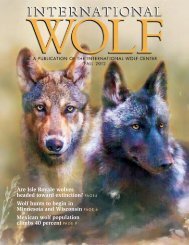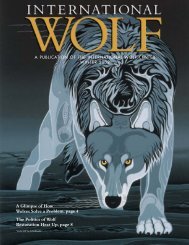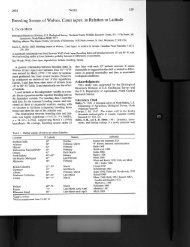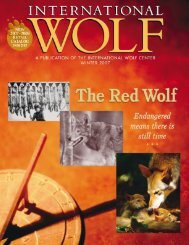a publication of the international wolf center spring 2007
a publication of the international wolf center spring 2007
a publication of the international wolf center spring 2007
You also want an ePaper? Increase the reach of your titles
YUMPU automatically turns print PDFs into web optimized ePapers that Google loves.
wolves would be more readily controlled,<br />
and Zone 4 is highly urban<br />
and agricultural areas where wolves<br />
would be discouraged. Michigan does<br />
not have a zone system, but nearly<br />
all wolves occur in <strong>the</strong> Upper<br />
Peninsula, which is separated from <strong>the</strong><br />
more agricultural and urban Lower<br />
Peninsula by <strong>the</strong> Great Lakes.<br />
The states also differ in <strong>the</strong> process<br />
for approval <strong>of</strong> management<br />
plans. In Minnesota <strong>the</strong> plan required<br />
legislative approval. The Michigan<br />
plan required approval by <strong>the</strong> DNR<br />
director. The Wisconsin plan<br />
required approval by <strong>the</strong> Wisconsin<br />
Natural Resources Board (state<br />
commission), but if public harvests<br />
are considered, legislative approval<br />
will be required.<br />
Lynn and Donna Rogers, www.bearstudy.org Zone 3 is marginal habitat in which<br />
So what will be <strong>the</strong> effects <strong>of</strong> <strong>the</strong>se<br />
plans on wolves in <strong>the</strong> region? The<br />
plans will likely cause <strong>wolf</strong> populations<br />
to stabilize in <strong>the</strong> region and<br />
perhaps cause some minor declines,<br />
especially near agricultural areas.<br />
Wolf distribution will probably stabilize<br />
and may shrink somewhat near<br />
agricultural regions. The Minnesota<br />
<strong>wolf</strong> population has already stabilized<br />
in its distribution to mainly<br />
heavily forested areas, probably due<br />
to lack <strong>of</strong> suitable habitat outside<br />
forests, higher mortality, and perhaps<br />
some impact from control programs.<br />
Slightly lower <strong>wolf</strong> numbers and<br />
more stabilized <strong>wolf</strong> range will not<br />
in any way endanger wolves in <strong>the</strong><br />
region. The <strong>wolf</strong> population in <strong>the</strong><br />
western Great Lakes region is viable<br />
and healthy. Along with high levels <strong>of</strong><br />
connectivity among <strong>the</strong> three states,<br />
this population is also well connected<br />
to <strong>the</strong> Canadian population <strong>of</strong> gray<br />
wolves. The greater intensity <strong>of</strong><br />
management <strong>of</strong> wolves allowed in<br />
<strong>the</strong> three states following delisting<br />
will improve local support for <strong>wolf</strong><br />
management, which ultimately will<br />
determine how many wolves <strong>the</strong><br />
region can hold. ■<br />
Adrian Wydeven is a mammal ecologist<br />
for <strong>the</strong> Wisconsin Department <strong>of</strong> Natural<br />
Resources in Park Falls, Wisconsin, and<br />
has led work on <strong>wolf</strong> management and<br />
recovery for Wisconsin since 1990.<br />
The states’ plans will likely cause <strong>wolf</strong><br />
populations to stabilize in <strong>the</strong> region<br />
and perhaps cause some minor declines,<br />
especially near agricultural areas.<br />
International Wolf Spring <strong>2007</strong> 7







